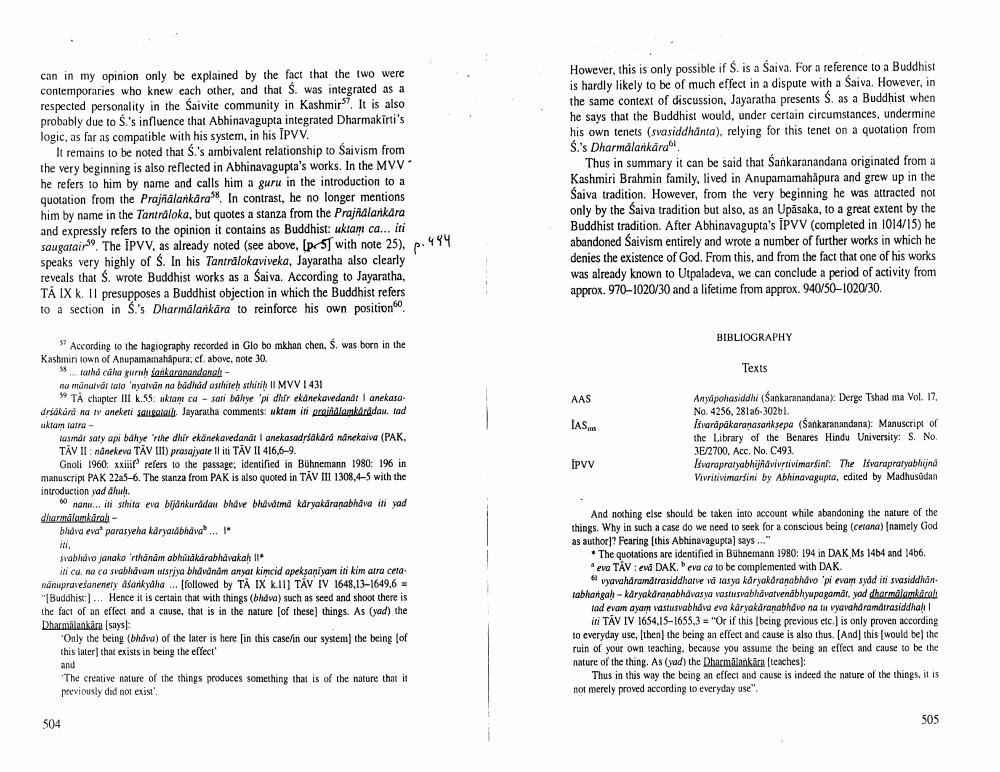________________
can in my opinion only be explained by the fact that the two were contemporaries who knew cach other, and that S. was integrated as a respected personality in the Saivite community in Kashmir. It is also probably due to Si's influence that Abhinavagupta integrated Dharmakirti's logic, as far as compatible with his system, in his IPVV.
It remains to be noted that S.'s ambivalent relationship to Saivism from the very beginning is also reflected in Abhinavagupta's works. In the MVV he refers to him by name and calls him a guru in the introduction to a quotation from the Prajñalankara. In contrast, be no longer mentions him by name in the Tantraloka, but quotes a stanza from the Prajfalankara and expressly refers to the opinion it contains as Buddhist: ukiam ca... iti saugatairs. The IPVV, as already noted (see above, p 5) with note 25). p.494 speaks very highly of S. In his Tantralokaviveka, Jayaratha also clearly reveals that S. wrote Buddhist works as a Saiva. According to Jayaratha, TĀ IX k. Il presupposes a Buddhist objection in which the Buddhist refers to a section in Si's Dharmalarkana to reinforce his own positions.
However, this is only possible if S. is a Saiva. For a reference to a Buddhist is hardly likely to be of much effect in a dispute with a Saiva. However, in the same context of discussion, Jayaratha presents S. as a Buddhist when he says that the Buddhist would, under certain circumstances, undermine his own tenets (svasiddhanta), relying for this tenet on a quotation from Si's Dharmálankára
Thus in summary it can be said that Sankaranandana originated from a Kashmiri Brahmin family, lived in Anupamamahapura and grew up in the Saiva tradition. However, from the very beginning he was attracted not only by the Saiva tradition but also, as an Upasaka, to a great extent by the Buddhist tradition. After Abhinavagupta's IPVV (completed in 1014/15) he abandoned Saivism entirely and wrote a number of further works in which he denies the existence of God. From this, and from the fact that one of his works was already known to Utpaladeva, we can conclude a period of activity from approx. 970–1020/30 and a lifetime from approx. 940/50–1020/30.
BIBLIOGRAPHY
Texts
AAS
LAS.
Anyápohasiddhi (Sankaranandana): Derge Tshad ma Vol. 17, No. 4256, 281a6-302b1. Isvarapakaranasariksepa (Sankaranandana): Manuscript of the Library of the Benares Hindu University: S. No. 3E/2700. Acc. No. C493. Isvarapratyabhijridvirtivimarsini: The Isvarapratyabhijnd Vivrikivimarsini by Abhinavagupta, edited by Madhusudan
ΠΡνν
According to the hagiography recorded in Glo bo mkhan chen, S. was born in the Kashmin town of Anupamamahapura, cf. above, note 30.
Ss. Kahdella guruh sankaranandanahna mánarvot lalo 'nyutan na bidhad asthiteh sthitih II MVVI 431
** TA chapter III k.SS. akram co-soti Mhrye 'pi dhir ekdnekawedandt anekasadrsäkárd na Ivaneketi Sauce , Jayaratha comments: wktam in prilamkanddau, tad aktam latre
lamde saty api dyerte dhir ekonekavedanát I anekasadrlalardndnekarva (PAK. TAV II:ndnekeve TAV III) prasajatellite TAV II 416,6-9.
Gnoli 1960: xxiif refers to the passage, identified in Bühnemann 1980: 196 in manuscript PAK 22a5-6. The stanza from PAK is also quoted in TAV III 1308.4-5 with the introduction yaddhah.
60 nanu... IN sthita eva Dijankurddau bidve bhdvåtmi karyakaranabhava iti yad dharmálamkarah
bhava eva" parasyeha karyabhava... " iti. svablid vo janakorthanam abhakarabhavakah *
iti cu ne ca svabhdam srjya bhdvdndm artyar kimcid apeksaniyam ini kim atra cetanapravesanenely dsakyaha ... [followed by TA IX kIIJ TÁV IV 1648,13-1649,6 = "Buddhis:) ... Hence it is certain that with things (bhdwa) such as seed and shoot there is the fact of an effect and a cause, that is in the nature of these things. As (yad) the Dharmálankara says:
"Only the being (bhava) of the later is here in this case in our system) the being lof this later that exists in being the effect'
And noching else should be taken into account while abandoning the nature of the things. Why in such a case do we need to seek for a conscious being celana) (namely God as author]? Fearing this Abhinavagupta) says..."
• The quotations are identified in Bühnemann 1980: 194 in DAK Ms 1464 and 1466.
eva TAV: evd DAKeva ca to be complemented with DAK
61 vyavad ramderasiddharve va tasya karyakranabhdvo pi evant sydd ini svasiddhantabhargah-karyakranabhdvas yavastusvabhävetvendbhyupo gamdr, ya dharulamalı
tad evam ayar vastusvabhdva eva karyakaranabhdvo na tu vyavahdramdirasiddhah
inTĀV IV 1654,15-1655,3 "Or if this being previous etc.) is only proven according to everyday use, then the being an effect and cause is also thus. (And this would be the ruin of your own teaching, because you assume the being an effect and cause to be the nature of the thing. As (yad) the Dharma ankara (teaches:
Thus in this way the being an effect and cause is indeed the nature of the things. it is not merely proved according to everyday use".
and
The creative nature of the things produces something that is of the nature that it previously did not exist
504
505




